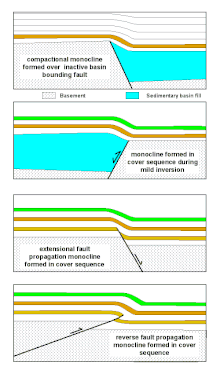



A monocline (or, rarely, a monoform) is a step-like fold in rock strata consisting of a zone of steeper dip within an otherwise horizontal or gently dipping sequence.
Formation
[edit]
Monoclines may be formed in several different ways (see diagram)
- By differential compaction over an underlying structure, particularly a large fault at the edge of a basin due to the greater compactibility of the basin fill, the amplitude of the fold will die out gradually upwards.[1]
- By mild reactivation of an earlier extensional fault during a phase of inversion causing folding in the overlying sequence.[2]
- As a form of fault propagation fold during upward propagation of an extensional fault in basement into an overlying cover sequence.[3]
- As a form of fault propagation fold during upward propagation of a reverse fault in basement into an overlying cover sequence.[4]
Examples
[edit]- Waterpocket Fold in Capitol Reef National Park, Utah[5]
- Comb Ridge in southern Utah[6]
- Grandview-Phantom Monocline in Grand Canyon, Arizona[7]
- Grand Hogback in Colorado[8]
- Lebombo Mountains in Southern Africa[9]
- Lapstone Monocline in the Blue Mountains (Australia)[10]
- Beaumaris Monocline in Victoria (Australia)[11]
- Purbeck Monocline on the Isle of Purbeck, Dorset, England[12]
- Fore-Sudetic Monocline, Poland[13]
- Sindh Monocline, Pakistan[14]
- Torres Flexure, southern Brazil[15]
See also
[edit]References
[edit]- ^ Skuce, A.G. (1996). "Forward modelling of compaction above normal faults: an example from the Sirte Basin, Libya" (PDF). In Buchanan, P.G.; Nieuwland, D.A. (eds.). Modern Developments in Structural Interpretation, Validation and Modelling. Special Publications. Vol. 99. London: Geological Society. pp. 135–146. ISBN 978-1-897799-43-7. Archived from the original (PDF) on 2012-03-16.
- ^ Chadwick, R.A. (1993). "Aspects of basin inversion in southern Britain". Journal of the Geological Society. 150 (2): 311–322. Bibcode:1993JGSoc.150..311C. doi:10.1144/gsjgs.150.2.0311. S2CID 131396080.
- ^ Willsey, S.P.; Umhoefer, P.J.; Hilley, G.E. (2002). "Early evolution of an extensional monocline by a propagating normal fault: 3D analysis from combined field study and numerical modeling" (PDF). Journal of Structural Geology. 24 (4): 651–669. Bibcode:2002JSG....24..651W. doi:10.1016/S0191-8141(01)00120-1. Archived from the original (PDF) on 2011-07-20. Retrieved 2011-01-09.
- ^ Finch, E.; Hardy, S.; Gawthorpe, R. (2003). "Discrete element modelling of contractional fault-propagation folding above rigid basement fault blocks". Journal of Structural Geology. 25 (4): 515–528. Bibcode:2003JSG....25..515F. doi:10.1016/S0191-8141(02)00053-6.
- ^ "Geology". Capitol Reef National Park. National Park Service. 23 December 2017. Retrieved 1 March 2018.
- ^ "Comb Ridge, Utah". earthobservatory.nasa.gov. 2019-11-24. Retrieved 2021-10-22.
- ^ Abbott, Lon; Cook, Terri (2004). Hiking the Grand Canyon's Geology. Seattle: The Mountaineers Books. pp. 99–114. ISBN 978-0-89886-895-1.
- ^ Murray, Frederick N. (1967). "Jointing in Sedimentary Rocks along the Grand Hogback Monocline, Colorado". The Journal of Geology. 75 (3): 340–350. Bibcode:1967JG.....75..340M. doi:10.1086/627261. JSTOR 30071521. S2CID 128672429.
- ^ Klausen, M.B. (2009). "The Lebombo monocline and associated feeder dyke swarm: Diagnostic of a successful and highly volcanic rifted margin?". Tectonophysics. 468 (1–4): 42–62. Bibcode:2009Tectp.468...42K. doi:10.1016/j.tecto.2008.10.012.
- ^ "L001 : Lapstone Monocline". Heritage places and items. Office of Environment and Heritage, Government of New South Wales. Retrieved 1 March 2018.
- ^ "61. Beaumaris Cliffs 3 - Monocline". Sites of Geological and Geomorphological Significance. Agriculture Victoria. 8 June 2017. Retrieved 1 March 2018.
- ^ Nowell, D.A.G. (1997). "Structures affecting the coast around Lulworth Cove, Dorset and syn-sedimentary Wealden faulting". Proceedings of the Geologists' Association. 108 (4): 257–268. Bibcode:1997PrGA..108..257N. doi:10.1016/S0016-7878(97)80011-9.
- ^ Kluska, B.; Rospondek, M.J.; Marynowski, L.; Schaeffer, P. (2013). "The Werra cyclotheme (Upper Permian, Fore-Sudetic Monocline, Poland): Insights into fluctuations of the sedimentary environment from organic geochemical studies". Applied Geochemistry. 29: 73–91. Bibcode:2013ApGC...29...73K. doi:10.1016/j.apgeochem.2012.09.010.
- ^ Memon, A.D.; Siddiqui, I.; Memon, A. (1999). "Tectonics of the Sindh monocline, Pakistan and their effects on hydrocarbons". Mehran University Research Journal of Engineering and Technology. 18 (2): 87–96.
- ^ Seth, H. (2018). Tectonic Deformation of Flood Basalt Provinces. Springer. ISBN 978-3-319-67704-0.
Well, that’s interesting to know that Psilotum nudum are known as whisk ferns. Psilotum nudum is the commoner species of the two. While the P. flaccidum is a rare species and is found in the tropical islands. Both the species are usually epiphytic in habit and grow upon tree ferns. These species may also be terrestrial and grow in humus or in the crevices of the rocks.
View the detailed Guide of Psilotum nudum: Detailed Study Of Psilotum Nudum (Whisk Fern), Classification, Anatomy, Reproduction